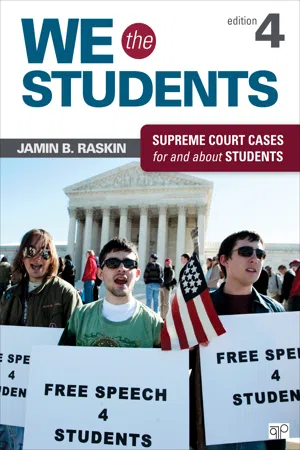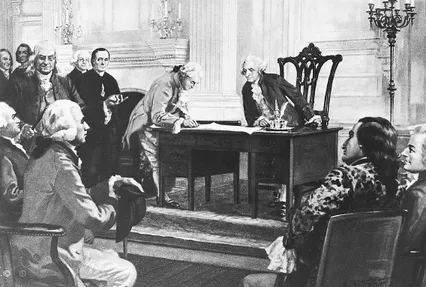![]()
1 “We the People”: Our Constitution and Courts
“A people who mean to be their own governors must arm themselves with the power which knowledge gives.”
JAMES MADISON (1822)
Have you ever had a problem at school? I bet you have.
This casebook is about problems students have at school. Of course, most problems you can resolve on your own or with the help of your friends, your parents, your teachers, or your principal. But some problems are so big, so complicated, so difficult, and so divisive that people have brought them to court as “cases” and have relied on the legal system to work them out.
This casebook focuses on the Supreme Court decisions about these hard cases affecting students at school in the United States. You will find cases about drug testing of students in extracurricular activities, censorship of student newspapers and campaign speeches, desegregation of Jim Crow schools, affirmative action in college admissions, religious prayer in the classroom and on the football field, and discrimination against girls' sports teams, to name just a few. In most of the decisions you will read, the Supreme Court uses the Constitution as the authoritative source of law to decide the case.
So before you sink your teeth into these cases, there is some basic information you need to have about our Constitution, our courts, and our legal process.
Why a Constitution?
Many high school students read William Golding's novel Lord of the Flies (1954). It tells the story of a group of shipwrecked English boys making their way alone on a desert island.
The boys create a fragile community with simple rules. They work together to find food and to keep the fire going. Whoever holds the conch seashell has the floor, and everyone listens when he speaks.
But one tough kid, Jack, has contempt for the community's ethics. He wants to lead a pack of “hunters” to go kill wild pigs. He ruthlessly teases an overweight cerebral boy named Piggy, who clings to the conch and to the embattled leader of the community, Ralph.
By the end of this riveting story, things have fallen apart. Jack's hunting crew turns savage and murderous. Chanting “Kill the pig, cut its throat, spill its blood,” they steal Piggy's glasses and make war on their classmates.
These boys never had a written constitution—only an informal verbal understanding, which could not restrain the selfish and violent impulses that destroyed the bonds of the group.
In democracies, citizens write constitutions to prevent power from being concentrated in one person, such as a king or a dictator, or a single faction, such as a political party, a church, or the military. A constitution tries to provide that conflicts will be resolved through law and that political change will take place nonviolently. An effective constitution secures essential rights to the individual.
Of course, the existence of a constitution is no guarantee of order, freedom, peace, or justice. Slavery, with all of its violence and horrors, defined life for millions of people in the United States for nearly a century under our Constitution (and for centuries before it was written). Nor did the Constitution succeed in ending slavery or the controversy over it. It took the Civil War, America's bloodiest conflict, which left hundreds of thousands of people dead on our soil, to abolish the “peculiar institution” and change the Constitution. The mere existence of a constitution does not prevent cruelty or oppression.
We can fairly say that a democratic and rights-protecting constitution is a necessary condition in modern life for political justice and stability, but it is not a sufficient one. The other necessary conditions are a decent level of provision for everyone in society to prevent a breakdown in order, political checks against total fear and a psychology of war, and an enduring loyalty to the constitution and rule of law in the hearts of the people.
The American Constitution: What is It?
The U.S. Constitution sets forth our nation's political structure, establishing both the powers of government and the basic rights of the people. The modern world's first written constitution: it is the glue that has held the nation together through civil war; recession; depression; world wars; the terror attacks of September 11, 2001; and profound social, economic, political, racial, sectional, and cultural conflict.
When the delegates to the Constitutional Convention in Philadelphia approved the Constitution on September 17, 1787, its provisions principally concerned structural issues—namely, the separation of powers, which refers to the distribution of powers among the legislative, executive, and judicial branches of the national government, and federalism, or the allocation of powers between the national government and the states.
Four years later, in 1791, freedom came bursting into the Constitution. In that year the states ratified the first ten amendments, called the Bill of Rights, which defined the rights of the people. The Bill of Rights had been championed by Anti-Federalists, who feared a tyrannical central government that would serve the aristocratic few. Under the new amendments, Congress could not establish a church or deny free exercise of religion, deny the right to assemble and petition for a redress of grievances, violate free speech or free press, conduct unreasonable or warrantless searches and seizures, or punish people twice for the same offense (double jeopardy).
Read through the Constitution and Bill of Rights in Appendix B. Ask yourself: What values were most important to our Founders? What would our Constitution be like without the Bill of Rights and later amendments? Do you agree with Thomas Jefferson that “no just government should refuse” a Bill of Rights?
The Constitution: Whose is It?
The Constitution begins “We the People.” These may be the three most important words in the document. They establish that, in America, the people are sovereign and the government works for us. Our Constitution embodied the ideas of John Locke, Jean-Jacques Rousseau, and Thomas Paine, Enlightenment thinkers who argued that all people have inalienable rights and that we create governments to secure those rights and promote the common good. In the Declaration of Independence, Thomas Jefferson wrote that governments derive “their just Powers from the Consent of the Governed,” implicitly contrasting this democratic concept with the monarchical idea that governmental power flows from God.
President Abraham Lincoln invoked the democratic principle in his Gettysburg Address, perhaps the greatest speech of American history, when he poetically proclaimed that “government of the people by the people for the people shall not perish from the earth.” It was the Civil War and the resulting Thirteenth, Fourteenth, and Fifteenth Amendments that ended slavery and launched the American people on a path toward equality for all.
The Constitution Defined the Structure and Powers of the National Government and, in Short Order, Set Forth a Bill of Rights for the People. Here the Founders Take Turns Signing their Names.
Source: Library of Congress.
Congress and the people of the states have the power to amend the Constitution on “great and extraordinary occasions,” as urged by James Madison in Federalist No. 49. Americans have exercised this power only seventeen times since the Bill of Rights was ratified (fifteen if you exclude our experiment with Prohibition and the amendment repealing it), almost always to expand our political rights or to try to perfect our vexed presidential election process. But if the people are the ongoing authors of the document, it is the Supreme Court that is the final interpreter of the meaning of constitutional language. At its best, the Supreme Court—along with the lower federal courts and state courts—acts as the guardian of our civil rights by striking down unconstitutional laws. This is the power of judicial review, by which the courts may declare “unconstitutional” and invalid any federal or state law or policy that violates rights, rules, or principles set forth in the Constitution.
The principle and practice of judicial review were established in the great case of Marbury v. Madison (1803), in which the chief justice of the United States, John Marshall, declared, “[I]t is emphatically the province and duty of the judicial department to say what the law is.” The Supreme Court announced its own constitutional power to strike down laws—even laws passed by an overwhelming majority in Congress or the state legislatures. In your opinion, does this make judicial review undemocratic? Or does it enrich our understanding of democracy by incorporating irrevocable commitments that we have made as a people to protect basic rights?
The Constitution: What does It Mean?
In some places, the Constitution seems very clear and specific, such as where it states that citizens must be thirty-five years old to become president. In other places, the Constitution speaks in broad, majestic generalities, such as where it says that states may not deprive persons of “equal protection of the laws” or abridge the “freedom of speech.”
How exactly the Supreme Court and other courts should interpret broad constitutional terms is an issue of enduring and fascinating controversy. To interpret the Constitution, the Supreme Court draws on
- the text of the Constitution itself;
- precedent, or rulings from factually similar cases that illuminate the Constitutions meaning;
- the intentions of the Framers;
- the history of the nation and its institutions;
- the general structure of the constitutional design based on the division of national, state, and local powers through federalism and the separation of powers among the legislative, executive, and judicial branches at the national level;
- the spirit and values of the Constitution embodied in the Bill of Rights; and
- practical concerns and requirements.
The Constitution does not enforce itself, nor do judges go out searching for violations. If people think that their constitutional rights are being violated and want judicial help, they must summon the courage and resources to bring a case to court themselves.
Under the Constitutions case-or-controversy requirement, which is set out in Article III, the federal courts may take only those cases brought by people who have a live controversy involving an actual injury. Our courts are not permitted to issue an “advisory opinion,” which is an abstract statement of how the court would rule on a legal matter that has not actually come before it. The “ripeness” doctrine says that a case or controversy must be present and “ripe” for deciding in order to be heard. At the same time, a case cannot be “moot,” no longer fit for judicial resolution because the controversy has passed away.
If there is no real injury alleged in a plaintiff's complaint, or the government is not responsible for it, or there is nothing t...

